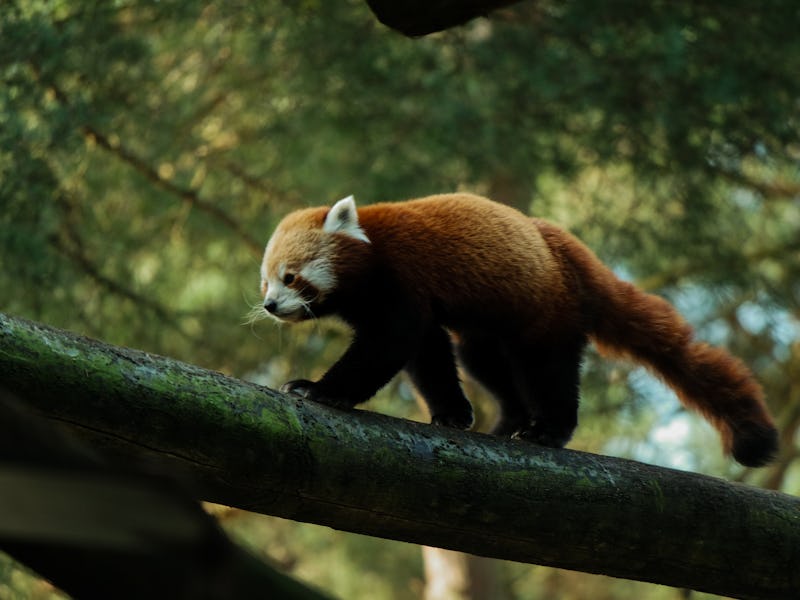The cutest animal in the world now has a rival
What creature is bushier-tailed, brighter-eyed, and fluffier than a red panda? The answer may surprise you.

Red pandas are possibly the cutest animals in existence. But now they have a rival. One that is fluffier, bushier-tailed, and just as bright-eyed.
New research reveals that red pandas are in fact made up of two distinct species: the Chinese red panda, Ailurus styani, and Himalayan red panda, Ailurus fulgens (this was the panda previously known to science).
Scientists had suspected that red pandas come in two varieties before, but this is the first genetic evidence for the distinction.
To make their discovery, the scientists analyzed the DNA of 65 red pandas living in the wild across Asia. They completed whole-genome sequencing of blood, muscle, and skin samples, drawn from pandas across seven different populations.
The two species have six distinct features that tell them apart:
Their size: Chinese red pandas are larger than their Himalayan counterparts, and have larger heads and teeth. They also have longer tails to charm you with.
Their faces: Himalayan red pandas have less red fur on their faces than Chinese red pandas, instead appearing more white in color.
Their fur: Chinese red pandas are fluffier than their Himalayan cousins, with 70 millimeter-long hair during winter compared to the Himalayan's 40-50 mm-long fur. Their coats are also darker than the Himalayan pandas' which, unlike their faces, tend to be redder than the Chinese red pandas'.
Their tails: Aside from being longer, Chinese red pandas have better-defined rings on those outsize tails, the researchers report.
Their location: Chinese red pandas live in southeastern Tibet and northern Myanmar, while Himalayan red pandas live in southern Tibet and Nepal. The researchers on this study believe that the Yalu Zangbu River divides the two populations, rebutting a previous hypothesis that the boundary is the Nujiang River.
Their diversity: Himalayan red pandas are less genetically diverse than their Chinese cousins, the researchers say. That is because after the two populations diverged, there was a bottlenecking event — an event, usually environmentally related, when populations see a sharp reduction in size — in the Himalayan red panda populations, the researchers say.
The Yalu Zangbu River divides two distinct species of red panda, new research suggests.
The findings were published Wednesday in the journal Science Advances.
Research informs conservation plans
Once roaming across Eurasia, red pandas now live only in the south and southeastern region of the Tibetan Plateau at altitudes of 2200 to 4800 meters. There are an estimated 10,000 red pandas left in the wild, according to the World Wildlife Fund.
Slightly larger than a house cat, the too-cute-for-comfort red pandas are “very skillful and acrobatic animals that predominantly stay in trees,” reports the WWF.
Having a better understanding of the endangered species can help direct the efforts to save them, say the authors of the new study.
Defining red panda species helps conserve them, researchers say.
The discovery that Himalayan red pandas are less genetically diverse is particularly useful, the researchers say. Less genetic diversity can be a barrier for survival. That is because as populations of an animal dwindle, their genetic diversity tends to suffer, and having fewer animals means lower chances of the gene pool recovering from any major setback, as a recent study of woolly mammoth remains shows.
Knowing there are two different red panda species gives researchers and conservationists a better sense of how to boost their ability to survive in the wild. Interbreeding between the two red panda species in captivity, for example, may work against the effort to preserve the two distinct populations.
Beyond defining the genetic boundaries between the two species of red panda, the researchers also identified three genetic populations within the Chinese red panda species. That finding suggests the species needs a different set of targeted conservation efforts for each population, the researchers say.
Cute pandas, cute science
Conserving these animals may be getting increasingly complicated, but come on — who wouldn’t want to conserve that face?
Come onnnn.
As for why red pandas are particularly irresistible to humans? Science has the answer. Our brains are hard-wired to connect with these sweet creatures, which, with their big eyes, small features, and round faces remind us of human babies — characteristics known as "baby schema."
Basically, seeing their faces triggers a built-in, care-giving response similar to that which a parent feels on seeing their infant. For some of us, that actually manifests as a desire to bite the red panda, as Inverse reported in 2016.
This is what is called a "dimorphous expression." The red pandas are so cute, your brain can't cope and so you feel an opposing emotion: aggression. Cute stuff, huh?
Abstract: The red panda (Ailurus fulgens), an endangered Himalaya-endemic mammal, has been classified as two subspecies or even two species – the Himalayan red panda (A. fulgens) and the Chinese red panda (Ailurus styani) – based on differences in morphology and biogeography. However, this classification has remained controversial largely due to lack of genetic evidence, directly impairing scientific conservation management. Data from 65 whole genomes, 49 Y-chromosomes, and 49 mitochondrial genomes provide the first comprehensive genetic evidence for species divergence in red pandas, demonstrating substantial inter-species genetic divergence for all three markers and correcting species-distribution boundaries. Combined with morphological evidence, these data thus clearly define two phylogenetic species in red pandas. We also demonstrate different demographic trajectories in the two species: A. styani has experienced two population bottlenecks and one large population expansion over time, whereas A. fulgens has experienced three bottlenecks and one very small expansion, resulting in very low genetic diversity, high linkage disequilibrium, and high genetic load.